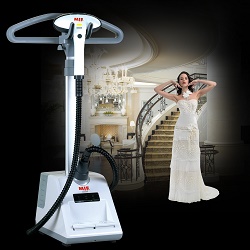Simple rules for installing dishwasher
If you are going to install the dishwasher yourself in the kitchen, ignorance of the process itself may lead to incorrect operation of the unit or its breakdown. Proper connection of the dishwasher to the water supply and sewage systems, as well as to the electrical network, is a guarantee of long and high-quality operation of the device. Often there are drawings to the dishwashers from which you can figure out how to install the dishwasher yourself.
Content
Choosing an installation site
Initially, before buying a unit, you should choose a place to install and connect the dishwasher. In a situation where the right place has not yet been selected, then several nuances should be taken into account.
- If you want to buy a built-in dishwasher, then it should fit to fit your kitchen furniture. Especially in height, so that the body could enter under the tabletop.Install the dishwasher can also be in the opening of the cabinet. Most often, in the case of installing a dishwasher in the finished kitchen, you will need to contact the furniture makers to upgrade the cabinet or cabinet to the unit dimensions.
- It should be noted at what distance entrance to the sewer. If the distance is above 1.5 meters, then the pump of the apparatus will work with increased load, and will soon fail. In rare cases, when the DIP cannot be properly placed in the kitchen, it can be placed in the bathroom.
- It is good, when nearby with the chosen place will be electric outlet. This will greatly facilitate the connection of the device to electricity.
After determining the appropriate place for the appliance, you can already think about how to connect the dishwasher with your hands to the sewage system and water supply, as well as to the power supply.
Connection to the water supply
This stage can be called the most time-consuming, because it takes a lot of time. But before you connect the dishwasher to the water supply, you first need to cut off the water supply, because you will need to install a tee.
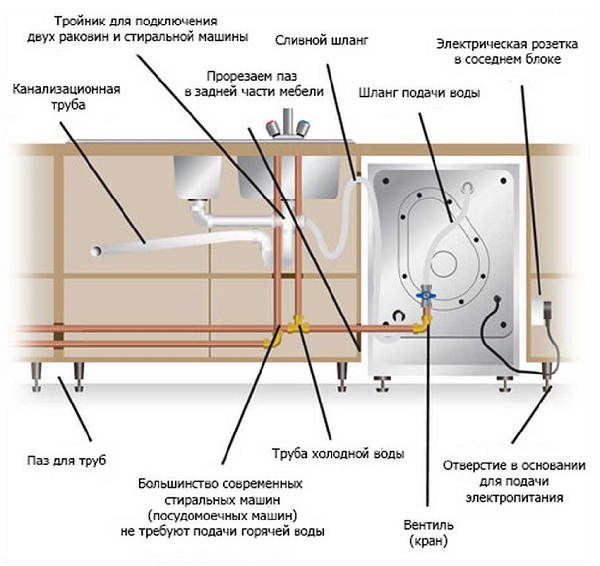
How to connect to the plumbing dishwasher
Connection is as follows.
- Find the place where the flexible hose from the mixer to the pipe is connected and unscrew it.
- After winding the FUM tape on the thread, fasten tee to this place. If desired, a check valve can be connected to the tee. But when installing a Bosch dishwasher, if you follow the installation instructions, the presence of a non-return valve is mandatory, although it is very picky about water quality.
- On top of the tee is unscrewed the hose from the mixer.
- Fine filter it is connected to the tap, and then the stopcock is screwed on. If you install the Bosch PMM with your own hands, then make sure that this filter is available, it is needed anyway, even if you have artesian water in the water supply system. When making all connections, it is necessary to rewind the FUM tape.
- Connect the water pipe from the dishwasher to the installed valve. But when installing and connecting a Bosch dishwasher, a standard gasket is placed as indicated in the installation instructions of the Bosch dishwasher. At a different location, a leak will appear.
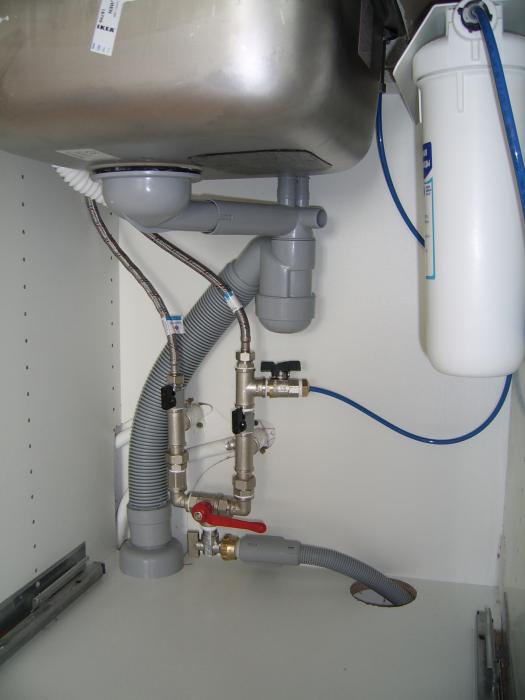
Connecting the hoses to the water supply
Note - connect the dishwasher according to the installation instructions, should be made only to the main line with cold water. Connection to hot water of any model of the dishwasher is not recommended due to the poor quality of the latter.
Although it attracts possible energy savings, but in the end, the repair of the device due to clogging or deterioration of assembly units will be more expensive. Also in electronics, a malfunction may occur if the water supply from the water supply system exceeds the temperature required by the chosen program.
When installing PMM in the country, the question arises how to connect a dishwasher to the water supply in its absence? Everything is solved simply: a tank with flooded water is installed on the roof (the height should be 2-3 meters above the apparatus to provide a pressure of 0.1 MPa) and a conduit is connected to the apparatus. But, before installing the dishwasher in the country, during the selection of the model in the store, pay attention to the installation instructions. There you should see if this water pressure is enough to operate the unit.
Drain connection
Connecting a dishwasher to the sewer seems easy.But you should consider a few unpleasant moments that may occur.
- Water trap is a prerequisite to prevent unpleasant odors from entering the dishwasher from the sewage system.
- In order to avoid the reverse flow of fluid from the sewage system into the apparatus, it is necessary to build in and arrange the drain hose so that upper loop was at a height not lower than 40-50 cm from the floor. This height is determined by the level of maximum filling of the bathroom. For example, if there is a problem with blockage of sewage, the released fluid from the bath, according to the law on communicating vessels, will rise to a general level, and can go to the MMP. The loop from the hose at the correct height will not allow this to happen.
- It is not recommended to make a tight connection of the drainage hose to the sewage system. This can play a bad role. The pressure in the system must be equalized with the atmospheric pressure in order to avoid its rarefaction. If it occurs, it can happen. siphon effect, when, with a large discharge of fluid in any area, it may begin to flow out on others that are connected to it.As a result, the contents of the sewage system is thrown into the dishwasher, or water begins to leak from the unit. All this can disable PMM.
But the connection without sealing is a source of leakage and unpleasant odors. There are two options for how to get out of this situation. The easiest and most inexpensive option is to purchase a special siphon with the presence of a nozzle to which you can connect household appliances. The figure shows that the siphon can also have 2 nozzles, for simultaneous connection of the washer and the PMM.
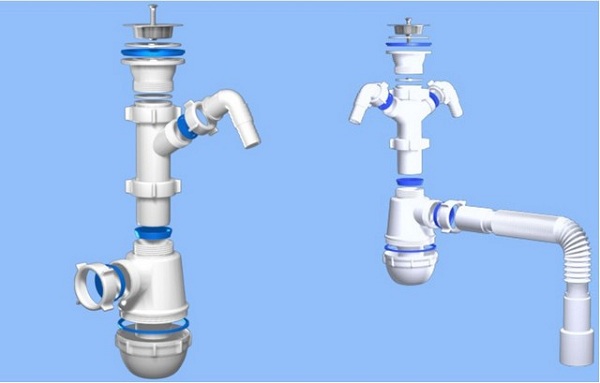
Siphon with one and two branch pipes
In the case of using such a siphon, when connecting a dishwasher, all the above troubles become impossible:
- the siphon design itself already provides its own water seal, which does not allow unpleasant odors;
- the channel bend is already formed by the top connection point of the drain hose;
- there is no tight connection between the hose and the sewage system, since the atmospheric pressure in the system is equalized through the inlet of the sink, due to which a siphon effect cannot occur.
But how to connect the units Bosch, Siemens, Electrolux and others,if the siphon is located far from the selected installation location, and the nearest place is a sewer? In this case, it is necessary to provide water seal and position the loop at the desired height.
- To do this, a special plastic insert is purchased, which must be attached to the wall at the correct height.
- The drain hose for the dishwasher is inserted into it so that the upper and lower curves in the shape of the letter “S” are obtained. A hose (drain) installed in this way, having a lower bend, will act as a water seal.
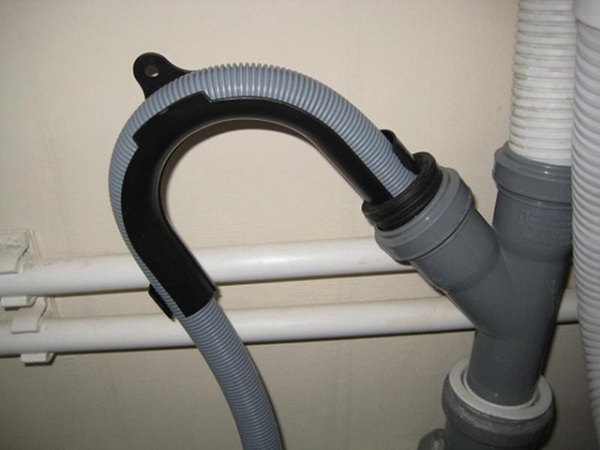
Plastic insert for hose
- To combat the siphon effect, a special antisiphon valve. The figure below shows an inexpensive valve that should be installed on the drain of a dishwasher. But it is not serviceable and requires replacement every six months.
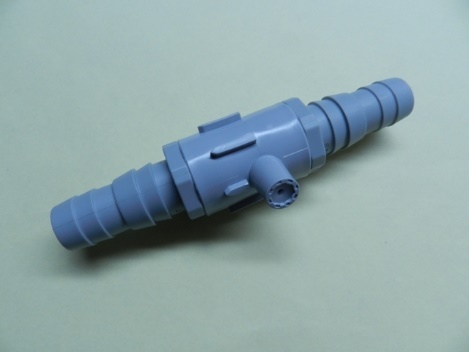
Antsiphon valve
There is a more expensive but convenient form of “anti-siphon” valves. They provide the necessary loop and amenable to cleaning.
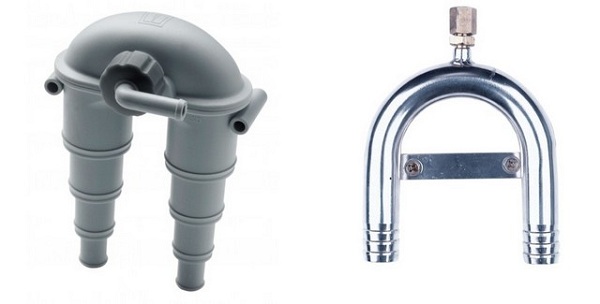
Antsiphonny valves
Electrical connection
The socket must be grounded, be designed for a current of 16A and not far from the device.
It is very important that the cable to connect the dishwasher has the right cross section of the conductor. Since PMM has a high capacity, it is considered that the diameter of the copper cable core should be not less than 2 mm. The wire must be stretched from the circuit breaker (16A), which will provide emergency shutdown in case of possible failures.
Connecting the device is prohibited without grounding. This is due to safety rules.
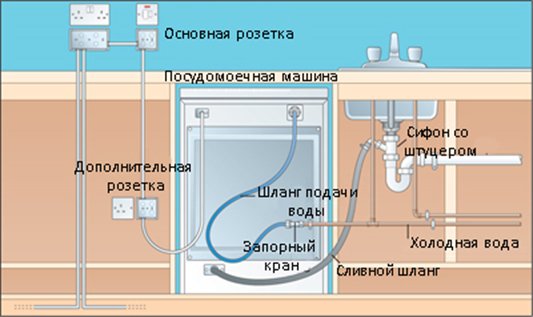
Electrical connection
The final stage of installation
Installing a built-in dishwasher in furniture specially ordered for this is easy. It is enough to level the unit by level, twisting the legs, push it into a niche under the tabletop and fasten it through special holes. Then attach the facade made by furniture makers, using a special template used for marking with the device. At all installation of facades dishwashers should be handled by craftsmen who assemble kitchen units. They will be able to withstand all the gaps when fixing the facade. This installation rule also applies to Bosch dishwashers.
Installing a dishwasher with your own hands in ready-made furniture will require some skills in handling the tool.
In order to insert the built-in dishwasher into the furniture, it is necessary to determine which built-in cabinet will need to be redone or removed altogether. The main thing is that its dimensions should not be less than body width. In most cases, the cabinet will need to be dismantled. For this:
- open the doors and look at its side racks - there should be visible “caps” of furniture screeds that connect the tables to each other during installation;
- unscrew them and knock them out of the holes;
- now you need to detach the cabinet from the tabletop - look up, it is bolted with ordinary screws to the canvas, through the strap tightening the cabinet;
- after removing the fastener, the bedside table can be easily pulled out, holding onto the legs;
- Now you can connect all communications using the rules described above, set the unit on the level and push it into a niche.
If this is fully embedded PMM, then you will need to order a facade in a furniture company. In the case of partially embedded, installation of the facade on the front panel of the dishwasher is not required, as it already has a decorative panel.
For clarity, how to install a dishwasher can be viewed in the video below.
In conclusion, we can say that if installing a PMM in kitchen furniture makes you difficult, then there are alternative versions of models of units, such as: detached PMM and desktop ones. You can connect them following the above recommendations.

/rating_off.png)






